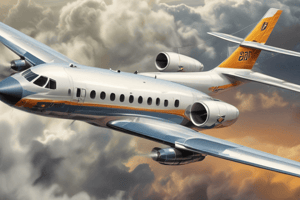Podcast
Questions and Answers
What happens to the air as the aircraft ascends?
What happens to the air as the aircraft ascends?
- It becomes denser
- It becomes thinner (correct)
- It remains the same
- It becomes turbulent
What is the primary reason excess weight reduces the rate of climb?
What is the primary reason excess weight reduces the rate of climb?
- It changes the wing's angle of attack
- It requires more thrust to produce lift (correct)
- It increases air resistance
- It affects the center of gravity
What is the term for the graph that plots an aircraft's capabilities in terms of altitude, airspeed, and weight?
What is the term for the graph that plots an aircraft's capabilities in terms of altitude, airspeed, and weight?
- Weight envelope
- Airspeed graph
- Performance envelope (correct)
- Performance chart
What is the primary purpose of consulting the performance charts provided by aircraft manufacturers?
What is the primary purpose of consulting the performance charts provided by aircraft manufacturers?
Why is it crucial to manage the weight of the aircraft?
Why is it crucial to manage the weight of the aircraft?
What happens if an aircraft is overloaded?
What happens if an aircraft is overloaded?
What factors are taken into account when calculating the maximum permissible weight?
What factors are taken into account when calculating the maximum permissible weight?
What is the term for the safety margins within the performance envelope?
What is the term for the safety margins within the performance envelope?
What is the primary consequence of not being able to reach a safe or efficient cruising altitude?
What is the primary consequence of not being able to reach a safe or efficient cruising altitude?
Why do pilots need to know the aircraft's current weight and maximum permissible weight?
Why do pilots need to know the aircraft's current weight and maximum permissible weight?
The performance envelope is affected only by airspeed and altitude.
The performance envelope is affected only by airspeed and altitude.
Aircraft can operate at maximum weight without any performance limitations.
Aircraft can operate at maximum weight without any performance limitations.
Payload has no effect on the overall weight of the aircraft.
Payload has no effect on the overall weight of the aircraft.
Pilots can plan the flight without consulting the performance charts provided by aircraft manufacturers.
Pilots can plan the flight without consulting the performance charts provided by aircraft manufacturers.
Aircraft will always be able to clear obstacles or weather systems regardless of its weight.
Aircraft will always be able to clear obstacles or weather systems regardless of its weight.
The rate of climb is not affected by the weight of the aircraft.
The rate of climb is not affected by the weight of the aircraft.
The maximum permissible weight is the same for all flight plans.
The maximum permissible weight is the same for all flight plans.
The performance of an aircraft is not affected by its weight.
The performance of an aircraft is not affected by its weight.
Calculations are not necessary to ensure the aircraft is not overloaded.
Calculations are not necessary to ensure the aircraft is not overloaded.
Aircraft manufacturers do not provide pilots with any information to determine the maximum altitude that can be safely reached.
Aircraft manufacturers do not provide pilots with any information to determine the maximum altitude that can be safely reached.
How does the thin air at high altitudes impact the engine's performance?
How does the thin air at high altitudes impact the engine's performance?
What is the primary consequence of operating an aircraft at or near its maximum weight?
What is the primary consequence of operating an aircraft at or near its maximum weight?
How does the payload affect the overall weight of the aircraft?
How does the payload affect the overall weight of the aircraft?
What is the significance of the performance envelope in aviation?
What is the significance of the performance envelope in aviation?
Why is it essential for pilots to calculate the maximum permissible weight before each flight?
Why is it essential for pilots to calculate the maximum permissible weight before each flight?
How do aircraft manufacturers support pilots in planning their flights?
How do aircraft manufacturers support pilots in planning their flights?
What is the relationship between an aircraft's weight and its ability to clear obstacles or weather systems?
What is the relationship between an aircraft's weight and its ability to clear obstacles or weather systems?
Why do pilots need to consider multiple factors when calculating the maximum permissible weight?
Why do pilots need to consider multiple factors when calculating the maximum permissible weight?
What is the primary goal of optimizing the distribution of cargo and passengers?
What is the primary goal of optimizing the distribution of cargo and passengers?
Why is it crucial for pilots to be aware of the aircraft's current weight and maximum permissible weight?
Why is it crucial for pilots to be aware of the aircraft's current weight and maximum permissible weight?
Flashcards are hidden until you start studying
Study Notes
Aircraft Weight and Takeoff Performance
- Each aircraft has a prescribed takeoff weight limit that must be respected to achieve the necessary performance.
- The weight of an aircraft dictates how much lift its wings must produce to get off the ground.
- The heavier the load, the more lift is needed, and consequently, the greater the takeoff speed must be.
- Takeoff roll (distance needed to reach takeoff speed on the runway) increases with increasing aircraft weight.
- Pilots must calculate takeoff variables carefully prior to each takeoff to maximize efficiency and safety.
Physics of Lift and Thrust
- Lift is a force that directly opposes the weight of the aircraft.
- When an aircraft is heavy, it needs more lift, which requires more airspeed, generated through a faster takeoff roll.
- Engines produce thrust, a forward-pushing force, which must overcome drag and weight to achieve lift-off.
Consequences of Overweight
- Performance during takeoff is compromised: the aircraft may struggle to lift off or may not climb adequately, endangering everyone on board.
- Load planning and strict adherence to weight regulations are non-negotiable in airline operations.
Weight and Climb Rate
- Climb rate is defined as the velocity at which an aircraft ascends.
- Heavier aircraft have a lower climb rate due to the increased weight requiring more lift and thrust.
- Climbing at heavier weights impacts fuel consumption and may compromise safety during critical flight phases.
- Precise loading, awareness of environmental factors, and knowledge of climb rate limits are crucial for a safe ascent.
Maximum Altitude Capabilities
- Maximum altitude (service ceiling) is the highest elevation at which the plane can maintain a specified rate of climb (usually no more than 100 feet per minute).
- Excess weight can reduce the rate of climb and limit the maximum altitude the aircraft can reach.
- Payload management is critical to ensure the plane can reach the necessary altitude for a given flight plan.
- Pilots must be aware of the aircraft's current weight and the maximum permissible weight for achieving the planned cruising altitude.
Aircraft Weight and Takeoff Performance
- Each aircraft has a prescribed takeoff weight limit that must be respected to achieve the necessary performance.
- The weight of an aircraft dictates how much lift its wings must produce to get off the ground.
- The heavier the load, the more lift is needed, and consequently, the greater the takeoff speed must be.
- Takeoff roll (distance needed to reach takeoff speed on the runway) increases with increasing aircraft weight.
- Pilots must calculate takeoff variables carefully prior to each takeoff to maximize efficiency and safety.
Physics of Lift and Thrust
- Lift is a force that directly opposes the weight of the aircraft.
- When an aircraft is heavy, it needs more lift, which requires more airspeed, generated through a faster takeoff roll.
- Engines produce thrust, a forward-pushing force, which must overcome drag and weight to achieve lift-off.
Consequences of Overweight
- Performance during takeoff is compromised: the aircraft may struggle to lift off or may not climb adequately, endangering everyone on board.
- Load planning and strict adherence to weight regulations are non-negotiable in airline operations.
Weight and Climb Rate
- Climb rate is defined as the velocity at which an aircraft ascends.
- Heavier aircraft have a lower climb rate due to the increased weight requiring more lift and thrust.
- Climbing at heavier weights impacts fuel consumption and may compromise safety during critical flight phases.
- Precise loading, awareness of environmental factors, and knowledge of climb rate limits are crucial for a safe ascent.
Maximum Altitude Capabilities
- Maximum altitude (service ceiling) is the highest elevation at which the plane can maintain a specified rate of climb (usually no more than 100 feet per minute).
- Excess weight can reduce the rate of climb and limit the maximum altitude the aircraft can reach.
- Payload management is critical to ensure the plane can reach the necessary altitude for a given flight plan.
- Pilots must be aware of the aircraft's current weight and the maximum permissible weight for achieving the planned cruising altitude.
Aircraft Weight and Takeoff Performance
- Each aircraft has a prescribed takeoff weight limit that must be respected to achieve the necessary performance.
- The weight of an aircraft dictates how much lift its wings must produce to get off the ground.
- The heavier the load, the more lift is needed, and consequently, the greater the takeoff speed must be.
- Takeoff roll (distance needed to reach takeoff speed on the runway) increases with increasing aircraft weight.
- Pilots must calculate takeoff variables carefully prior to each takeoff to maximize efficiency and safety.
Physics of Lift and Thrust
- Lift is a force that directly opposes the weight of the aircraft.
- When an aircraft is heavy, it needs more lift, which requires more airspeed, generated through a faster takeoff roll.
- Engines produce thrust, a forward-pushing force, which must overcome drag and weight to achieve lift-off.
Consequences of Overweight
- Performance during takeoff is compromised: the aircraft may struggle to lift off or may not climb adequately, endangering everyone on board.
- Load planning and strict adherence to weight regulations are non-negotiable in airline operations.
Weight and Climb Rate
- Climb rate is defined as the velocity at which an aircraft ascends.
- Heavier aircraft have a lower climb rate due to the increased weight requiring more lift and thrust.
- Climbing at heavier weights impacts fuel consumption and may compromise safety during critical flight phases.
- Precise loading, awareness of environmental factors, and knowledge of climb rate limits are crucial for a safe ascent.
Maximum Altitude Capabilities
- Maximum altitude (service ceiling) is the highest elevation at which the plane can maintain a specified rate of climb (usually no more than 100 feet per minute).
- Excess weight can reduce the rate of climb and limit the maximum altitude the aircraft can reach.
- Payload management is critical to ensure the plane can reach the necessary altitude for a given flight plan.
- Pilots must be aware of the aircraft's current weight and the maximum permissible weight for achieving the planned cruising altitude.
Studying That Suits You
Use AI to generate personalized quizzes and flashcards to suit your learning preferences.




